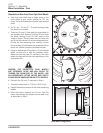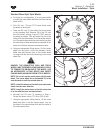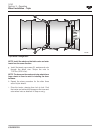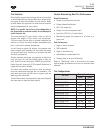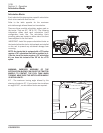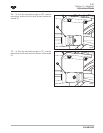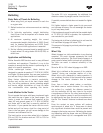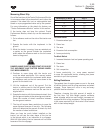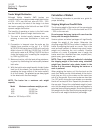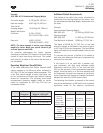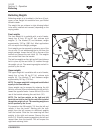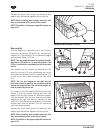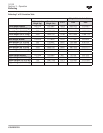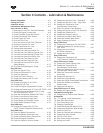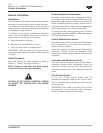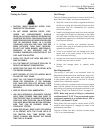
3-100
435/485/535
Tractor Weight Distribution
Although Buhler Versatile 4WD tractors are
manufactured with an approximate weight distribution
of 65% - 67% over the front axle and 33% - 35%
over the rear axle, the intent of the design is to have
the tractor operating in the field with an ideal 50/50
dynamic weight distribution.
The benefits of operating a tractor in the field under
the ideal 50/50 dynamic weight distribution are:
1. The work is divided equally between the axles,
allowing a more even distribution of work and
load.
2. Compaction is lessened since the axles are the
lightest force possible on the soil. If a 13,636
kg (30,000 lbs) tractor has a 50/50 split, each axle
exerts a force of 6,818 kg (15,000 lbs). A 60/40
split would create an 8,182 kg (18,000 lbs) force
under the heavier axle, increasing the compaction
by 1364 kg (3000 lbs).
3. Maximum traction, with the least rolling resistance,
is gained by distributing the load equally between
both axles.
4. With the total tractor weight equally divided (under
load) on all four wheels, you increase reliability by
spreading the torque output of the tractor equally
to all four wheels. The greatest torque always goes
to the wheels with the most weight.
NOTE: The tractor has a maximum axle weight
capacity:
Model Maximum continuous weight per axle
435 27,000 lbs.
485 30.000 lbs.
535 32,000 lbs.
(Based on 100 lbs/hp x 60%)
Calculation of Ballast
The following information is provided as a guide for
proper ballasting:
Shipping Weight and Fore/Aft Ratio
The shipping weight of the tractor will be approximate
distributed at 65% - 67% on the front axle and 33%
- 35% on the rear axle.
Do not assume that every tractor will come from the
factory with this weight distribution.
Various options and wheel packages will significantly
change the weight of the tractor. Determine the
shipping weight BEFORE any ballast is added to the
tractor by weighing the tractor on a scale. This is the
most accurate method of determining actual tractor
weight and ballasting the unit correctly. Possible
locations of a scale of adequate size to weigh the
tractor would be a feed/fertilizer store, asphalt plant,
gravel quarry, grain elevator, etc.
NOTE: There is an additional method of calculating
the shipping weight of the tractor using calculated
weight from theoretical value charts located in the
Section 6 of this manual. Weighing the tractor on a
scale is preferred.
When weighing the tractor, pull the front axle on the
scale first. Make sure the inside wheels of the dual or
triple tires are fully on the scales and the outer tires
are off of the ground. Since most scales are less than
3 m (10
") wide, driving the inner wheels up on wooden
blocks will accomplish this. Repeat this procedure for
the rear axle. Record the unballasted weight of each
axle. Add the weight recorded for each axle together to
get a total tractor shipping weight. Divide the individual
axle weights by the total tractor shipping weight to get
the front to rear weight distribution percentage.
Section 3 - Operation
Ballasting



